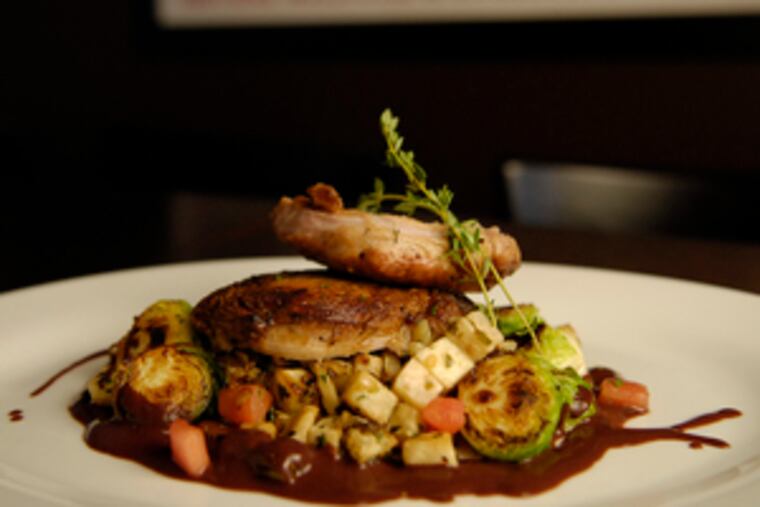
AT COQUETTE Bistro and Raw Bar, the menu has a French accent, but the dishes are reassuringly familiar: rich onion soup, a grilled hanger steak with a pat of butter melting on top, roasted chicken with mashed potatoes, and the like.
The Queen Village restaurant-bar is part of a new wave of places aiming to be authentically French, but not so haute you can't throw back a beer with your plate of mussels and frites, or stop by for a glass of wine and a light meal of salade or paté.
These newcomers aren't trying to compete with Le Bec-Fin. They want to be your mid-priced, go-to neighborhood spot.
Cochon is a country French BYOB on the border between Queen Village and Bella Vista that debuted last month. Zinc Bistro a Vins is a wine reinvention, from the owner of Center City's Caribou Cafe, of the former Wash West BYOB La Boheme as a restaurant and wine bar.
That homey French cooking is suddenly trendy makes sense to Cary Neff, a native of the area and veteran restaurateur who also owns the quintessentially Philly Sansom Street Oyster House.
"I think it has to do with the feel and vibe you get in a restaurant like this - there's a realness to it," Neff said. "People feel good in places like this. They don't feel like they have to put on any airs when they walk in. You can come in shorts, you can come in flip-flops, you can order a glass of beer.
"I think French bistros like this and the other ones opening up right now offer that kind of vibe, and by the way, the food is great, and you can have fun with it."
At the same time, all three restaurants approach their French connections differently.
For Olivier Desaintmartin, a native of the Champagne region who has lived in the United States for more than a decade, the bistro is still second nature. He based his cozy version - which has exposed brick walls, mirrors as accents and a zinc bar (naturellement) modeled after an antique one dating from 1919 - on his favorite bistros from the Marais section of Paris.
The menu offers the kind of comfort food his mother served him and the types of dishes you'll still find scribbled on a chalkboard in a typical Parisian cafe.
There's a spinach and goat cheese omelette, escargots in puff pastry, rabbit stew and the requisite steak frites, as well as a raw bar.
You can sip an old-school aperitif like a kir royale (Champagne with creme de cassis) while perusing the menu, and select from a changing rotation of 25 French wines by the glass.
"Who are these Americans opening French restaurants?" Desaintmartin said half-jokingly. "For me, it's all in the flavor from the plates you grew up with in your mother's kitchen. That's how I test my food. I smell it. If it smells good, it's got to be good."
In contrast, Coquette owner Neff has yet to visit Paris but took inspiration from the popular New York bistros Balthazar and Pastis, as well as images from books and the Internet.
His lack of international credentials doesn't seem to matter - the lively Coquette has the look down, from the zinc bar and the hexagon-tile floor to brown paper covering the table tops, and the rattan tables and chairs lining the sidewalk during the warm-weather months.
The food is similarly traditional, but it was no easy process to finalize the menu.
"We started with a blackboard with over 150 items on it and slowly got rid of one or two items a day, until we were comfortable with it - and then getting the look of each dish," he said.
Meanwhile, Gene Giuffi, co-owner, with his wife, Amy, of Cochon, has been to France twice but comes to his country-French style by way of his native Brooklyn and stints cooking in top Philly kitchens like Pasión, Nan and Davio's.
His menu includes such bistro staples as mussels with tomato-leek saffron broth, and steak frites, as well as his own inventive spin on la cuisine Francaise: dishes like wild striped bass over sweet pea risotto with saffron beurre blanc; slow-roasted pork shoulder over lentils, topped with a poached egg; and braised, free-range lamb shank with rutabaga, fingerling potatoes and crimini mushrooms.
"It's basically the food I like to cook," Giuffi said. "I like homey foods."
For their corner spot - familiar to many as the longtime location of Sud, a patisserie turned Moroccan cafe - they were able to blend original details (decorative tin and subway tile on the walls and a vintage, hexagon tile floor) with modern touches (an open kitchen, sleek black Wenge-wood tables and chairs, and a palette of chocolate brown and medium blue).
Unlike the others, Cochon is proudly a BYOB and doesn't charge a corkage fee.
"Why should [customers] pay 300 percent markup on wines when they decide what they want to drink?" Giuffi asked.
In the end, though, these new bistros are really about paying homage to a long-standing French tradition that still seems timely.
"I think French cuisine has always been the backbone of any gourmet cuisine . . . it's never going to go away," Desaintmartin said. "Some people remember where they had a meal in France in the '60s, and they can find the same thing here because it never got old.
"It's like a painting - it never got old." *
Robert DiGiacomo is a Philadelphia-based writer.